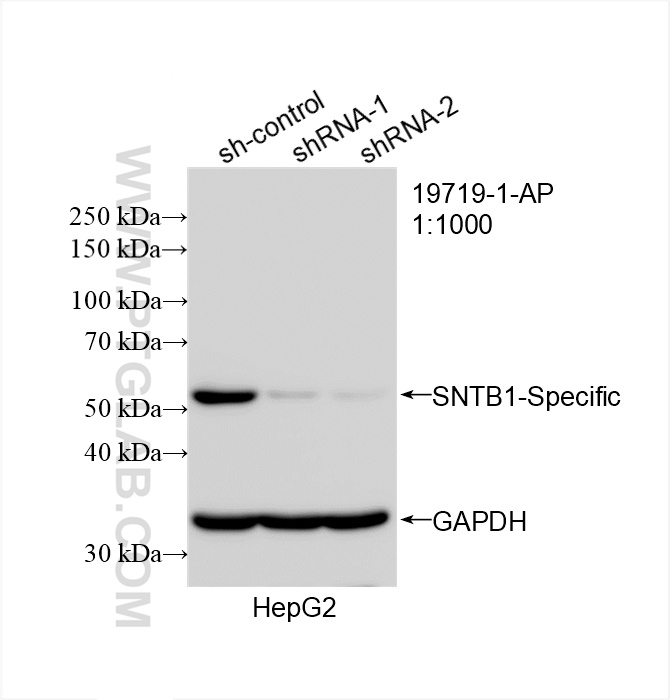验证数据展示
经过测试的应用
| Positive WB detected in | HepG2 cells, mouse liver tissue |
推荐稀释比
| 应用 | 推荐稀释比 |
|---|---|
| Western Blot (WB) | WB : 1:500-1:1000 |
| It is recommended that this reagent should be titrated in each testing system to obtain optimal results. | |
| Sample-dependent, Check data in validation data gallery. | |
产品信息
19719-1-AP targets SNTB1-Specific in WB, ELISA applications and shows reactivity with human, mouse samples.
| 经测试应用 | WB, ELISA Application Description |
| 经测试反应性 | human, mouse |
| 免疫原 |
Peptide 种属同源性预测 |
| 宿主/亚型 | Rabbit / IgG |
| 抗体类别 | Polyclonal |
| 产品类型 | Antibody |
| 全称 | syntrophin, beta 1 (dystrophin-associated protein A1, 59kDa, basic component 1) |
| 别名 | SNTB1, Syntrophin-2, SNT2B1, BSYN2, Beta-1-syntrophin |
| 计算分子量 | 58 kDa |
| 观测分子量 | 58 kDa |
| GenBank蛋白编号 | NM_021021 |
| 基因名称 | SNTB1 |
| Gene ID (NCBI) | 6641 |
| RRID | AB_3669312 |
| 偶联类型 | Unconjugated |
| 形式 | Liquid |
| 纯化方式 | Antigen affinity purification |
| UNIPROT ID | Q13884 |
| 储存缓冲液 | PBS with 0.02% sodium azide and 50% glycerol, pH 7.3. |
| 储存条件 | Store at -20°C. Stable for one year after shipment. Aliquoting is unnecessary for -20oC storage. |
背景介绍
SNTB1, also named as SNT2B1, BSYN2 and TIP-43, belongs to the syntrophin family. SNTB1 is an adapter protein that binds to and probably organizes the subcellular localization of a variety of membrane proteins. It may link various receptors to the actin cytoskeleton and the dystrophin glycoprotein complex. This antibody is specific to SNTB1.
实验方案
| Product Specific Protocols | |
|---|---|
| WB protocol for SNTB1-Specific antibody 19719-1-AP | Download protocol |
| Standard Protocols | |
|---|---|
| Click here to view our Standard Protocols |



